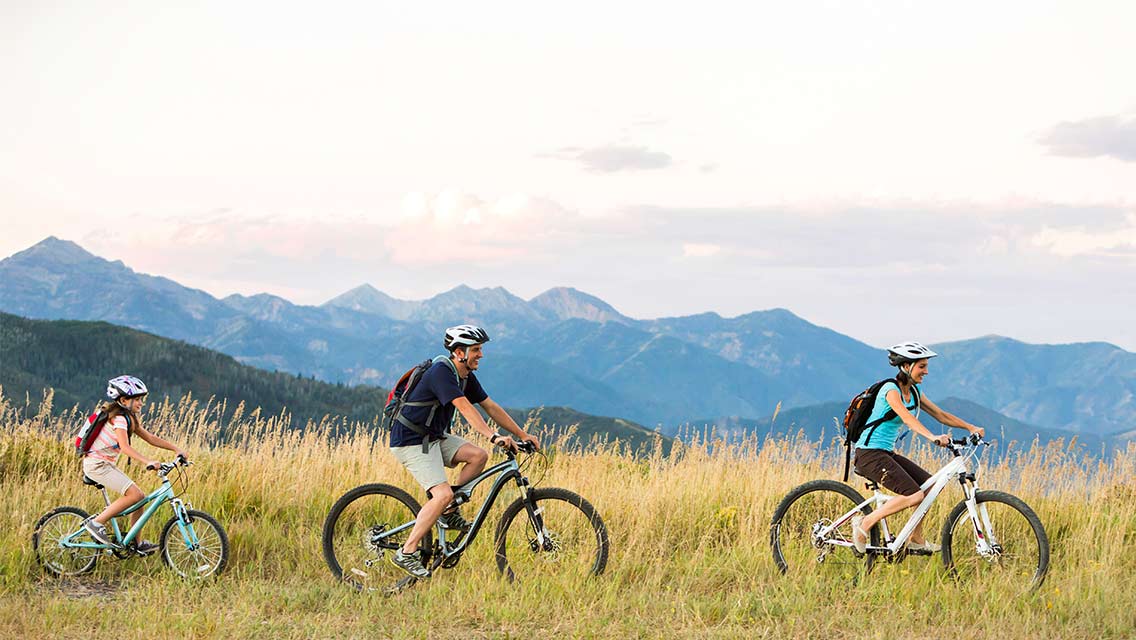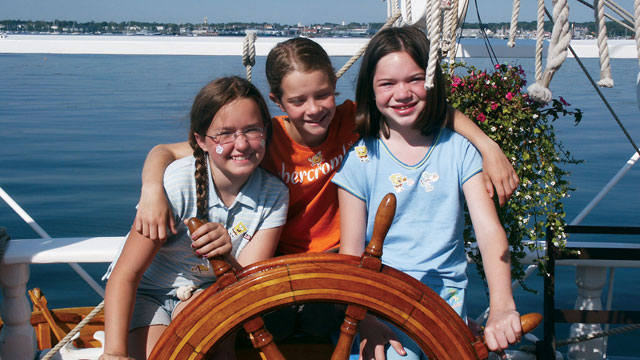Parents and children alike gasp as they spot a bright purple starfish clinging to the rocks beneath the sparkling Pacific tide. Later, young and old heads bump together over a wet tray of wriggling dragonfly nymphs scooped from a clear stream. The next day, the group plies the waters of Washington’s Lake Crescent in a 32-foot canoe, listening to a biologist describe the plant and animal life they’re seeing.
Is this a school field trip? Are the children the lucky offspring of scientists? No, these are just families on vacation – but a different kind of vacation: the kind where moms, dads and kids head into the great outdoors with learning in mind, as well as adventure. You might call it an “edu-venture.”
Trips that combine outdoor adventure with education are becoming more and more popular, particularly with families who are looking for meaningful, memorable experiences they can have together. The idea behind these “learning on the go” vacations, which run the gamut from oceanside hikes to archeology digs, is that most families go on vacation not just to escape home but to deepen their bonds and enjoy some quality time together. Because edu-ventures place your crew in the midst of an active discovery experience, they help bring everyone into the present moment together, sparking conversation and creating lots of interesting memories to share.
Staying Power
One big advantage of edu-ventures is that they can help expose your kids to interests and insights that, unlike an unlimited-ride armband, stick with them for life. “Our family educational trips offer a lot more value than, say, a typical vacation activity like shopping,” notes DeeAnn Nelson, who plans the Olympic Park Institute’s “Water, Water Everywhere” family camp, an immersion experience in the heart of Olympic National Park.
Dick Davis, a retired businessman from Seattle, learned the value of combining education and adventure when he joined the Crow Canyon Archaeological Center in Colorado for a weeklong trip with his wife and their 11-year-old granddaughter. The week included rafting, horseback riding and hiking with an expert staff of archeologists and numerous Native American tribal members.
Having access to top-notch scholars who also understand kids’ needs “is one of the great aspects of a trip like this,” says Davis. But he counsels against announcing or overemphasizing the “learning” part of the adventure. “If you tell kids you’ve planned an educational trip, they’ll think that it is going to be terrible,” he explains, noting that you can expect lots of groans and resistance in response to anything that sounds remotely like school.
Sparking Interest
Regardless of the adventure you choose, be sure to cater to your kids’ attention spans, interests and energy levels. That means avoiding too-long hikes and too-long lectures, but it also means thinking like a kid when you’re reviewing programs. While history and geology may be fascinating to some kids, most are more easily drawn in by here-and-now experiences: things they can see, hear and touch in real time.
Idaho Adventures, a company offering a variety of educational river trips, including ones focusing on Lewis and Clark, natural history and geology, has a sure winner to capture the attention of budding naturalists: “We often bring along our scat collection,” says Idaho Adventures guide Mark Troy. “Scat,” kids quickly learn, means dried animal droppings.
Of course, not all kids go in for gross. If your kids lean more toward the romantic or artistic, you have to plan accordingly. One highlight for Davis’s granddaughter Brittney was the ruggedly magnificent hike to Canyon de Chelly with a Navajo guide, who played his flute beneath the overhanging red-sandstone rock formations and later plied the group with freshly prepared fry bread, a delicious Native American treat. “We enjoyed the trip so thoroughly that we are returning this year with two other grandkids,” remarks Davis.
It goes without saying that the adventure should also be intriguing to the adults on the trip. Generally, edu-ventures are designed for families, which means their programs are developed with both adults and kids in mind. But it also means that you are expected to shepherd your children through the experience: You won’t be lounging by the pool while your offspring go off with the guides.
Of course, if it’s bonding and quality time you’re after, that’s probably just fine with you – and your children. “Kids get a kick out of knowing that their parents are learning at the same time as they are,” says Troy of Idaho Adventures.
Plan Your Own
Fully outfitted trips are convenient, but resourceful families can also design their own educational itineraries, often at a lower cost. Designing your own edu-venture allows you to tailor it to your family’s schedule, interests and age levels. It also makes it easier to emphasize fitness priorities like longer hikes and healthier food choices. But again, be careful not to go overboard on the “good for you” part, or your kids are likely to dig in their heels.
To plan your own edu-venture, you’ll need to do advance research by telephone, Internet and guidebook. Your best bet: state and national parks. The agencies managing these parks have a mandate to provide education about the resources they protect. Their Web sites include schedules for family classes, ranger-led hikes and guided outings with local experts.
Even do-it-yourself hikes can be highly informative when they offer interesting brochures and signage. To dissuade the kids from blasting past interpretive signs, try this role-reversal version of the pop quiz: Have your children take turns reading the signs aloud and then let them try to stump you with questions based on the material they just read.
Seaside Variety
Coastal parks are rich with opportunities to observe wildlife and explore beaches, cliffs and caves. Leaping dolphins and breathtaking hikes with sweeping ocean views characterize a trip to the Channel Islands National Park near Oxnard, Calif.
Karen Patterson, a California writer whose family trips nearly always involve fitness-friendly activities like camping, climbing and kayaking, took her 13-year-old son on a fall boat excursion to Anacapa Island, one of the jewels in the island chain. After they landed on the island, a ranger-led hike offered the opportunity to learn about nesting seabird activity in the spring. “My son Mike was fascinated to hear the ranger’s description of the number of birds and their territorial noise and commotion,” says Patterson.
Variety is key to family edu-ventures, and Anacapa is a good example of how families use many methods to explore the environment. Janis Flippen, a consultant for tourism in the area, says families visiting Anacapa also kayak to nearby sea caves and bike the paved route around Oxnard Beach Park that passes first along windswept sand dunes and then beside the Channel Islands Harbor. Many families also use the beach volleyball courts and stop at the Ventura County Maritime Museum to learn about the area’s seafaring history.
Lewis and Clark
If your family is turned on by history, you’re in luck: With the approach of the Lewis and Clark bicentennial, a history trip along the explorers’ trail (especially through Montana) offers an outstanding mix of outdoor recreation and educational opportunities.
Built into a scenic bluff overlooking the Missouri River, the Lewis and Clark National Historic Trail Interpretive Center in Great Falls contains exhibits detailing the 1804–1806 expedition. This exceptional museum experience can be combined with an eight-mile bike ride on River’s Edge Trail to see the series of waterfalls that daunted Lewis and Clark’s team, the Corps of Discovery.
The ultimate Lewis and Clark adventure is a canoe trip on the Upper Missouri River in Montana, a wild waterway that has changed little from when the Corps of Discovery navigated it two centuries ago. Just like the early explorers, families can encounter elk, white-tailed deer, muskrats, bald eagles and pelicans on the gentle waters. This is a trip that can be easily planned by families with some canoeing experience. For those lacking experience, support abounds: The National Park Service Lewis and Clark National Historic Trail Web site (www.nps.gov/lecl/VisitorInfo/tour.htm) lists both outfitters and canoe rental opportunities.
Dinosaur Dig
If your idea of relaxation is to have someone else plan your vacation, consider a dig for fossils. Paleontology trips offer a bonanza of outdoor and learning opportunities. For example, the Museum of Western Colorado in Grand Junction offers one- to five-day family dinosaur-quarry digs every summer in an area of Colorado and Wyoming known as the “dinosaur diamond.” Mornings are spent excavating, and in the afternoons, families visit museum galleries and take behind-the-scenes tours to learn the art of preparing fossils for study and display.
For information-intensive trips like this one, some advance study can help increase kids’ interest. Sharing nightly selections from related books or magazines can help build your family’s excitement. You might even consider dovetailing an edu-venture with a school subject your child is already studying. But take care not to push the serious, academic side of edu-ventures too hard.
Whether you’ve studied ahead or not, keep the emphasis on fun and discovery. And whether you’ve planned your own trip or signed on with an outfitter, leave plenty of time for relaxation and serendipity.
Too much pre-planning backfired for Sharon McCoy, who recently explored Lewis and Clark’s trail in Washington State with her daughter. “We were disappointed one evening that we were unable to attend a last-minute invitation to a powwow because we had hotel reservations in the next town, too many miles away,” says McCoy.
Fortunately, McCoy got a second chance to be spontaneous. “At another place, our guidebook told us that there were prehistoric drawings on some rocks in a particular area, but we couldn’t find them,” McCoy says. “Then, during a pit stop, we asked a park ranger, and he was so excited that we knew about the drawings that he drove us to their location and then gave an impromptu tour. We were so glad we had extra time built in.”
More than anything, though, most kids will appreciate the opportunity to move, explore and discover on their own. “The real key to a successful educational trip is keeping it active,” notes Debbie Northrop, whose family just returned from an Alaska adventure that included clam digging, hiking and kayaking. “That’s it, really. The subject matter and the kids will take it from there.”
Family Learning Adventures
Lewis and Clark – To plan a Montana trip, visit http://lewisandclark.state.mt.us. For a canoe trip, see the Lewis and Clark National Historic Trail Web site at http://www.nps.gov/lecl/VisitorInfo/tour.htm. Idaho Adventures offers a three-day Lewis and Clark family adventure covering 45 river miles; $395 for adults and $350 for children under 16. Visit www.idahoadventures.com.
Family Excavation – The weeklong archeological family trip costs $950 for adults and $750 for children between ages 12 and 17. Visit www.crowcanyon.org.
Channel Islands National Park – Details on touring Anacapa Island can be found by exploring the National Park Service site at www.nps.gov/chis.
Dinosaur Dig – The Museum of Western Colorado’s three-day dinosaur adventure costs $695 per person. Visit www.dinodigs.org.
Elderhostel – Offers a number of intergenerational educational programs, including an action-packed week in Yellowstone National Park that includes exploring thermal features and lava caves. Visit www.elderhostel.org.



This Post Has 0 Comments